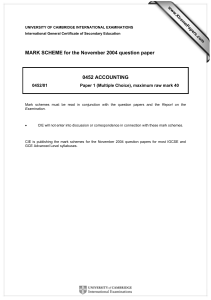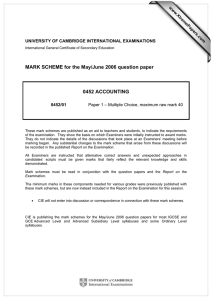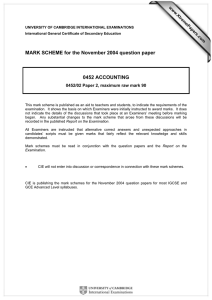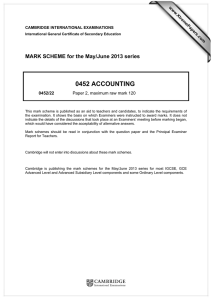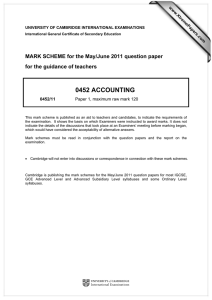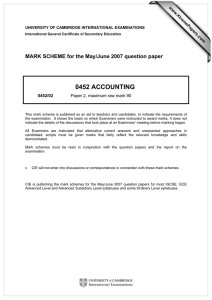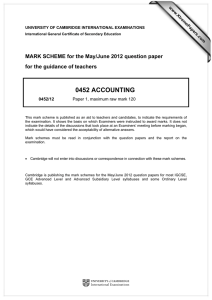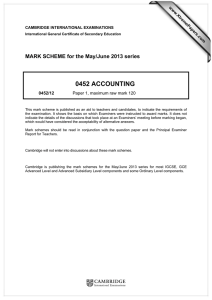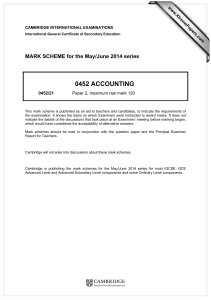MARK SCHEME for the May/June 2006 question paper 0452 ACCOUNTING www.XtremePapers.com
advertisement
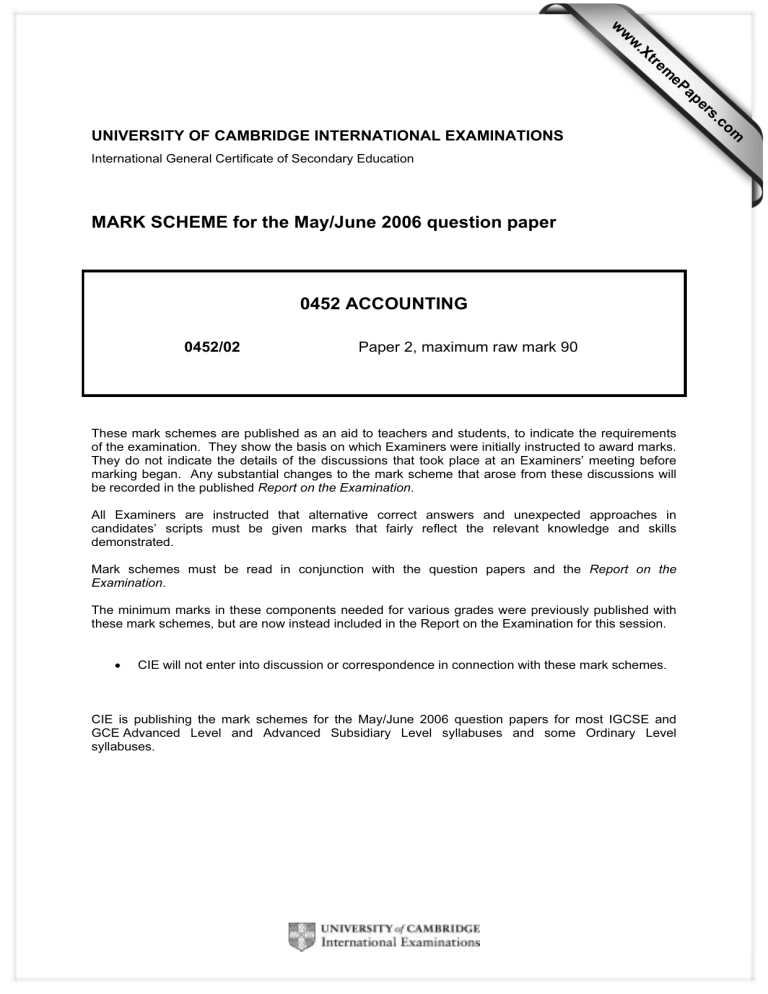
w w ap eP m e tr .X w International General Certificate of Secondary Education MARK SCHEME for the May/June 2006 question paper 0452 ACCOUNTING 0452/02 Paper 2, maximum raw mark 90 These mark schemes are published as an aid to teachers and students, to indicate the requirements of the examination. They show the basis on which Examiners were initially instructed to award marks. They do not indicate the details of the discussions that took place at an Examiners’ meeting before marking began. Any substantial changes to the mark scheme that arose from these discussions will be recorded in the published Report on the Examination. All Examiners are instructed that alternative correct answers and unexpected approaches in candidates’ scripts must be given marks that fairly reflect the relevant knowledge and skills demonstrated. Mark schemes must be read in conjunction with the question papers and the Report on the Examination. The minimum marks in these components needed for various grades were previously published with these mark schemes, but are now instead included in the Report on the Examination for this session. • CIE will not enter into discussion or correspondence in connection with these mark schemes. CIE is publishing the mark schemes for the May/June 2006 question papers for most IGCSE and GCE Advanced Level and Advanced Subsidiary Level syllabuses and some Ordinary Level syllabuses. om .c s er UNIVERSITY OF CAMBRIDGE INTERNATIONAL EXAMINATIONS Page 1 Question Number 1 (a) Mark Scheme IGCSE – May/June 2006 Syllabus 0452 Question (including any source details) Paper 02 Part Mark [1] Cash book (b) Matching [1] (c) Fixed assets [1] (d) A transaction completely omitted from the books e.g. cash sales not recorded [1] (e) Discount received Carriage outwards Interest on bank deposit Bad debt written off Income (1) (1) Expense (1) (1) [4] (f) Interest on capital, partners salaries, interest on drawings (any two) [2] (g) Current assets less current liabilities [2] (h) (i) $200 less $65 = $135 [1] (ii) Missing voucher or $10 lost/pilfered from cash box [2] (i) Current assets less stock/current liabilities [2] (ii) Shows whether the business has sufficient liquid assets to meet its current liabilities [2] (i) Total marks [19] © University of Cambridge International Examinations 2006 Page 2 Question Number 2 (a) Mark Scheme IGCSE – May/June 2006 Syllabus 0452 Question (including any source details) Paper 02 Part Mark Loretti Journal Office furniture Stock Bank Cash Loan – Hassan Capital – Loretti $ 1 500 12 000 5 300 200 19 000 $ (1) (1) (2) (1) 3 000 (1) 16 000 (2) 19 000 [8] See next page for 2 (b) © University of Cambridge International Examinations 2006 Page 3 Mark Scheme IGCSE – May/June 2006 Syllabus 0452 © University of Cambridge International Examinations 2006 Paper 02 Page 4 Question Number 3 (a) Mark Scheme IGCSE – May/June 2006 Syllabus 0452 Question (including any source details) Hilota – Trial balance at 31 March 2006 $ Fixed assets 22 000 (1) Provision for depreciation Stock at 1 April 2005 3 200 (1) Balance at bank 1 550 (1) Sales Sales returns 500 (1) Purchases 34 200 (1) Carriage outwards 950 (1) Rent 4 000 Wages 7 200 (1) General expenses 2 600 Capital Drawings 9 600 (1) Totals 85 800 Paper 02 Part Mark $ 9 300 (1) 56 500 (1) 20 000 (1) 85 800 (1) to agree total [12] (b) Hilota Trading account for the year ended 31 March 2006 $ $ Sales 56 500 less sales returns 500 56 000 Opening stock 3 200 (1) Purchases 34 200 (1) 37 400 less closing stock 3 800 (1) Cost of goods sold 33 600 Gross profit 22 400 (1) (1) (1) (1) OF [7] (c) (d) Gross profit percentage = Gross profit/net sales = 22 400 (1)(OF)/56 000 (1) x 100 = 40.00% (1) [3] If no sales returns, use gross sales: Gross profit percentage = 22 900 (1)(OF)/56 500 (1) x 100 = 40.43% (1) [3] Total marks [25] © University of Cambridge International Examinations 2006 Page 5 Question Number 4 (a) Mark Scheme IGCSE – May/June 2006 Syllabus 0452 Question (including any source details) Part Mark [3] Stock is valued at the lower (1) of cost (1) and net realisable value (1) (b) Paper 02 Rudi- stock valuation $ Part A005: 250 (1) units @ $1.30 per unit (1) Part B017: 600 (1) units @ $1.80 per unit (2) Part C060: 150 (1) units @ $2.50 per unit (1) add: carriage inwards 3 x $25 = $ 325.00 (1) 1 080.00 (1) 375.00 (1) 75.00 (1) 450.00 1 855.00 (1) Total value of stock [12] (c) Prudence [2] Total marks [17] 5 (a) Rajit Summary Balance Sheet at 31 December 2005 Cost Provision for Net book depreciation value $ $ $ Fixed assets 62 500 Current assets less current liabilities Net current assets/working capital (1) 12 500 47 000 19 000 Financed by Capital at 1 January 2005 Add Profit for the year (1) 50 000 (1) (1) 28 000 78 000 (1) (1) 74 000 (1) 13 000 (1) 87 000 9 000 (1) 78 000 (1) to agree balance less drawings [10] (b) Return on capital employed = profit/opening capital = 13 000 (1)/74 000 (1) = 17.57% (1) [3] Total marks [13] © University of Cambridge International Examinations 2006
